Why the delay?
Gads! It’s been a long time since I’ve written to you. That’s because I’ve been on the road (to Costa Rica) and on deadline (with the December “Fast Company” business issue of GrowerTalks) and have been too swamped with my day job to indulge in the fun of Acres Online. I’ll tell you about both adventures in this edition. Which, by the way, is roughly the 716th that I've written (why that is significant will become clear in an upcoming issue).
I saw a Beacon!
Beacon? What beacon? Beacon impatiens! Beacon is the name that PanAmerican Seed has given to its highly anticipated Impatiens Downy Mildrew-resistant impatiens series (“high resistance” is the technical designation approved by the International Seed Federation). I wrote about Beacon in the March GrowerTalks when it was still a numbered variety. Now it’s named, and has a launch schedule: a soft launch in 2019, with much of the availability going to high-IDM regions like the UK, South Africa and the Southern U.S. I saw the parent plants at PanAmerican’s production facility in Costa Rica last week, and workers were busy making crosses and harvesting seed. It’s coming to market!
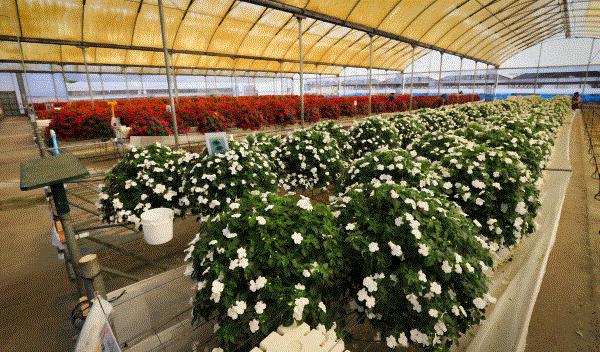
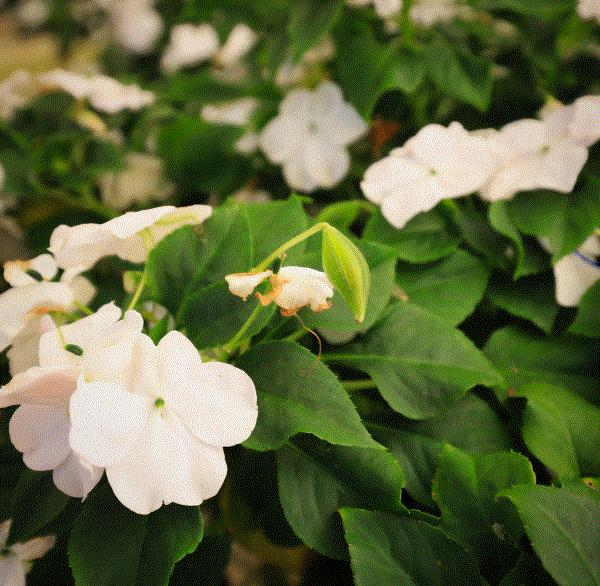
A Beacon White seed pod, just about ready to harvest.
A couple of points:
First, about the name: Beacon came from PanAm’s new Global Sales Director Sean Valk, my traveling companion last week in Costa Rica. Sean says the name symbolizes “a light in the darkness, bringing color to the shade.”(Six colors, to be precise.)
There’s a second significance: Beacon is a solution to a serious plant disease problem that most consumers aren’t even aware of—most just simply noted that they can’t find impatiens in their garden centers anymore without really knowing why (more on this in a second).
As for availability, Beacon will be available through all the standard distribution channels—nobody gets an exclusive. That’s because impatiens are such an historically important part of the bedding plant world, PanAm wants to do what’s best, long-term, for the industry.
Now, will you be able to grow them in 2019, the soft-launch year? Perhaps, if you’re lucky, and fast. It would help if you’re in a high-IDM region. After January 1, get on the horn with your favorite broker to find out. PanAm is making millions of seed, but that’s not much when you’re talking about a globally important variety. But remember, it’s officially a “soft launch.” By January 2020, they expect to have enough seed to meet the global demand.
Beacon: giving back
One more bit of Beacon news: PanAmerican Seed has decided to donate a portion of the proceeds from the sale of Beacon impatiens to a charity. Nothing too unusual in that. But in the spirit of IDM—a serious, but little-known plant disease—PanAm will be selecting a little-known but significant charity to be the benefactor each year. No word yet on which charity will be selected for 2019, but we’ll keep you posted.
Webinar on beneficial nematodes coming Dec. 13
My next GrowerTalks webinar will feature the one and only Suzanne “Buglady” Wainwright waxing poetic on one of her favorite topics: beneficial nematodes. She’ll be joined by Julie Graesch, a scientist with BASF, who will help her cover today’s nematode production methods and the pros and cons of each, along with some solid basics on using nematodes—various species, target pests, formulations, application methods and the latest research.
Mark your calendar for Thursday, December 13, at 1 p.m. Eastern/Noon Central.
If you want to use nematodes to control western flower thrips, fungus gnats and shore fly, you’ll want to attend this free webinar!
Sign up at www.growertalks.com/webinars
A special thanks to sponsor BASF, for putting the “free” in free webinar.
Healthy Water webinar archived
My friend and fellow Gator Dr. Paul Fisher presented a fantastic webinar last week on two aspects of healthy water: how to filter out pesticides and PGRs; and the details on dissolved oxygen. (You know the best way to improve the oxygen level in your root zone? “Turn off the tap,” he recommends.) You’ll get that and much more if you register to watch the archived webinar.
You’ll find it at the same place as the nematode webinar above: www.growertalks.com/webinars (just scroll down the page to the archives).
At Linda Vista
I had to skim back to the top of this treatise to see if I had mentioned that I’d been to Linda Vista … yup, I mentioned it. Yes. And believe it or else, I am the first GrowerTalks editor, other than the great Vic Ball himself, to visit Costa Rica and their Linda Vista production facility, which was founded by none other than Claude Hope, the originator of the F1 impatiens (among other crops). I got to stay in the guest house and sign the guest book and everything!
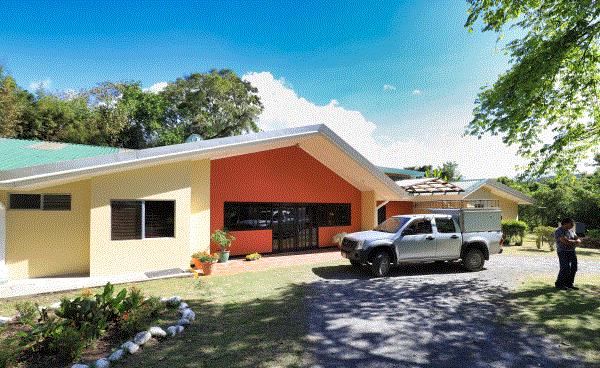
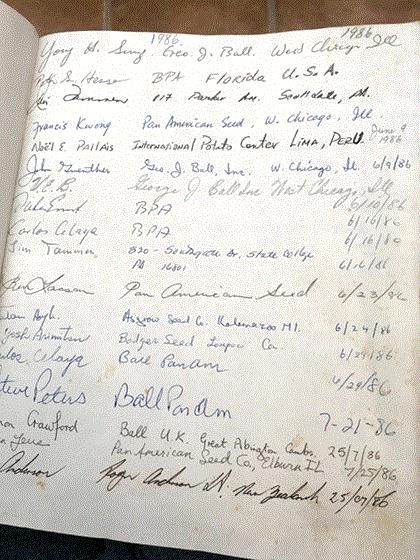
Page 1 of the guestbook, dating back to 1986.
I was there because PanAm is making a major investment in their seed production greenhouses and have added a big new seed processing facility as well. I toured all three of their farms and shot as many photos and as much video as I could in two days.
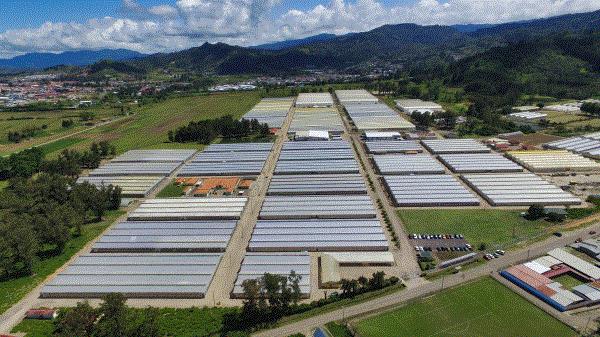 Linda Vista Farm 2. The Francis Kwong Center is the white roof, center right.
Linda Vista Farm 2. The Francis Kwong Center is the white roof, center right.
And, just as importantly, I wanted to know where bedding plant seeds come from. I’ve seen cutting production facilities in Guatemala, El Salvador, Nicaragua and Mexico, but never a seed facility; and let me tell you, it’s a complicated business! Consider that cutting production simply requires a certain number of clean, nice parent plants from which one takes cuttings, which are then packaged and shipped north for sticking.
To make seed, PanAmerican has to maintain two different parent plants for each variety (thanksfully, many parents make more than one offspring variety). Workers have to take pollen from the male parents' flowers (by hand or vacuum) and apply it to the stigmas of the female parents' flowers, then wait several weeks for the seed pods to develop. They then harvest the pods by hand (at just the right time), and bring the pods to the seed processing facility for cleaning and grading by size and quality. Lots of moving parts in the process! And lots of human touch points, and skill requirement. I got to try my hand at hand pollinating, and let me tell you, it makes you appreciate seed annuals a whole lot more!
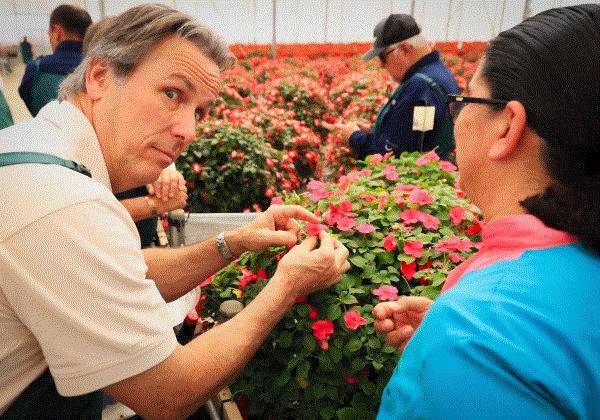
I think I'll leave this to the experts. Otherwise, you'll get about 10 seeds a month.
I was also impressed by the number of young people PanAm has in leadership roles at Linda Vista. They’ve got a training program that helps them identify and mentor young employees, and it seems to be working quite well.
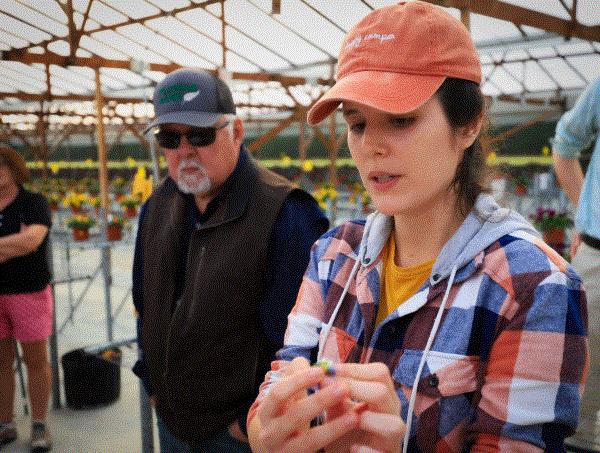
Learning about pansy seed production from Andrea Riera, production manager of Farm 3. Andrea is originally from Ecuador.

Francis Kwong Center
Francis Kwong was a long-time PanAmerican Seed scientist who was responsible for much of the modern seed production technology and techniques the company uses today to produce its billions and billions of flower seeds. A native of southern China who came to the U.S. in 1969, Francis set up and ran the company’s seed production research department for more than 30 years. Alas, he passed away in 2017 at the too-young age of 65 after fighting colon cancer.
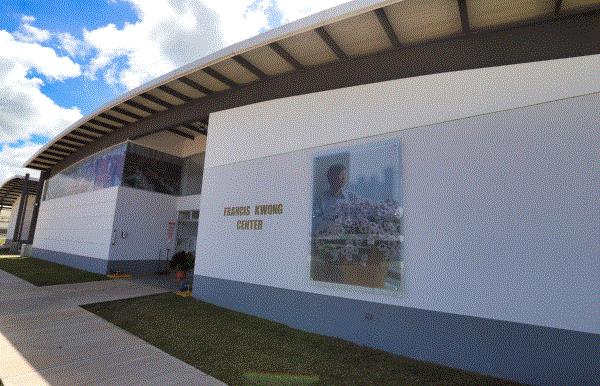
Francis’s legacy is now preserved not just in seed but in brick and mortar at the new Francis Kwong Center at Linda Vista, a state-of-the-art seed processing facility located in the center of Farm 2, Linda Vista’s largest (53 acres under cover) location.
It’s a beautiful, shiny facility, filled with the latest seed processing equipment that allows Linda Vista to clean and grade seed before shipping it north to West Chicago for final processing (coating, pelleting, priming and packaging) before it’s shipped to your greenhouse. The operation is so efficient, about 80% of PanAm’s seed now gets processed here instead of in the U.S.

I think Francis would be both humbled and pleased about the place … but I’m sure he’d also be looking for ways to make it even better!

About the December issue
I mentioned at the intro that I’ve been slammed by deadlines for the December issue of GrowerTalks/Green Profit. That’s because it’s one of our more interesting of the year. For GrowerTalks, it’s what we call our “Fast Company” issue, in which we emulate the best of the best ideas from that iconic business magazine (we even borrow their logo font). On the Green Profit side, we publish our annual Style issue, which delves into the fashion and décor side of our industry.
I’ve got stories on both sides of the publication: an interview with Benary’s co-managing director Matthias Redlefsen about how to find your successor when you don’t have kids who want to come into the business (in his former life he was a succession-planning consultant); and a quick five-question profile of young floral designer Jacob McCall, whom I met in Florida last May. He’s funny, quirky and immensely talented; I’d love to see him doing work with our product and not just cut flowers. Well, when I tell you he got his first floral industry job at age 11, you know he’s very into what he does.
Possibly the coolest story in the whole package, however, is Jen Zurko's cover profile of Maria Costa Smith, matriarch of Costa Farms. You don't want to miss it!

Finally …
Where am I this time? Poinsettia trials! Yesterday (Thursday), I was with Jen Zurko, video camera in hand, at the N.G. Heimos Greenhouses & Millstadt Young Plants 2018 Poinsettia Trials. It’s near St. Louis, about a 4 1/2 hour drive from our Chicagoland offices—a long haul! But worth it, as it’s our only Midwest opportunity to view poinsettia trials and check out what’s in the pipeline. I’ll report on that next time, plus share a link to the new cultivar video we shot. Snoopy the drone came along, too, and took a flight in a snow storm!
See you next time,

Chris Beytes
Editor
GrowerTalks and Green Profit
This e-mail received by 23,314 loyal readers!
Thanks to my loyal sponsors, who help me reach the 23,314 readers of Acres Online in 66 countries. Want to be one of them (a sponsor, that is)? Give Paul Black a shout and he'll hook you up.